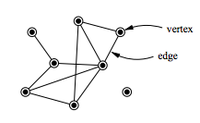
Photo from wikipedia
MOTIVATION Node embedding of biological entity network has been widely investigated for the downstream application scenarios. To embed full semantics of gene and disease, a multi-relational heterogeneous graph is considered… Click to show full abstract
MOTIVATION Node embedding of biological entity network has been widely investigated for the downstream application scenarios. To embed full semantics of gene and disease, a multi-relational heterogeneous graph is considered in a scenario where uni-relation between gene/disease and other heterogeneous entities are abundant while multi-relation between gene and disease is relatively sparse. After introducing this novel graph format, it is illuminative to design a specific data integration algorithm to fully capture the graph information and bring embeddings with high quality. RESULTS First, a typical multi-relational triple dataset was introduced, which carried significant association between gene and disease. Second, we curated all human genes and diseases in seven mainstream datasets and constructed a large-scale gene-disease network, which compromising 163,024 nodes and 25,265,607 edges, and relates to 27,165 genes, 2,665 diseases, 15,067 chemicals, 108,023 mutations, 2,363 pathways, and 7.732 phenotypes. Third, we proposed a Joint Decomposition of Heterogeneous Matrix and Tensor (JDHMT) model, which integrated all heterogeneous data resources and obtained embedding for each gene or disease. Forth, a visualized intrinsic evaluation was performed, which investigated the embeddings in terms of interpretable data clustering. Furthermore, an extrinsic evaluation was performed in the form of linking prediction. Both intrinsic and extrinsic evaluation results showed that JDHMT model outperformed other eleven state-of-the-art (SOTA) methods which are under relation-learning, proximity-preserving or message-passing paradigms. Finally, the constructed gene-disease network, embedding results and codes were made available. DATA AND CODES AVAILABILITY The constructed massive gene-disease network is available at: https://hzaubionlp.com/heterogeneous-biological-network/. The codes are available at: https://github.com/bionlp-hzau/JDHMT.
Journal Title: Journal of biomedical informatics
Year Published: 2022
Link to full text (if available)
Share on Social Media: Sign Up to like & get
recommendations!